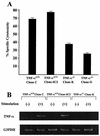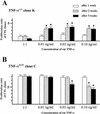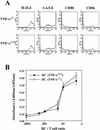Lack of tumor necrosis factor alpha induces impaired proliferation of hepatitis B virus-specific cytotoxic T lymphocytes
- PMID: 12551985
- PMCID: PMC141095
- DOI: 10.1128/jvi.77.4.2469-2476.2003
Lack of tumor necrosis factor alpha induces impaired proliferation of hepatitis B virus-specific cytotoxic T lymphocytes
Abstract
Recent studies have shown that tumor necrosis factor alpha (TNF-alpha) plays critical roles in not only viral clearance but also lymphoid tissue development and stem cell differentiation. In this study, we attempted to induce hepatitis B virus (HBV)-specific cytotoxic T lymphocytes (CTLs) by immunization of TNF-alpha knockout (TNF-alpha(-/-)) mice with HBsAg-encoding plasmid DNA. An immunization with the HBV plasmid failed to induce CTL responses in TNF-alpha(-/-) mice, although CTLs were readily induced in wild-type mice by the same protocol. Weak CTL responses were produced in TNF-alpha(-/-) mice after two sessions of immunization with the HBV plasmid; however, TNF-alpha was required to maintain the responses of these CTL lines to in vitro stimulation and, even then, the responses were lost after 3 weeks. Interestingly, a limiting dilution of a CTL line showed that HBV-specific CTL clones with high specific cytotoxicity were present in TNF-alpha(-/-) mice, but these clones again failed to proliferate for more than 3 weeks. Furthermore, since exogenously added TNF-alpha enhanced the proliferation of a TNF-alpha(-/-) clone but suppressed that of a TNF-alpha(+/+) clone in vitro, TNF-alpha also has a direct effect on the proliferation of CTLs. In conclusion, TNF-alpha is essential rather than important for the proliferation of HBV-specific CTLs both in vivo and in vitro and this effect is not only due to the activation of dendritic cells but is also induced by the direct effect on CTLs.
Figures






Similar articles
-
Dendritic cell immunization breaks cytotoxic T lymphocyte tolerance in hepatitis B virus transgenic mice.J Immunol. 1998 Nov 1;161(9):4520-9. J Immunol. 1998. PMID: 9794377
-
Induction of CTL responses and identification of a novel epitope of hepatitis B virus surface antigens in C57BL/6 mice immunized with recombinant vaccinia viruses.Virus Res. 2001 Jan;73(1):17-26. doi: 10.1016/s0168-1702(00)00219-7. Virus Res. 2001. PMID: 11163641
-
Role of TNF-alpha produced by nonantigen-specific cells in a fulminant hepatitis mouse model.J Immunol. 2009 Jan 1;182(1):391-7. doi: 10.4049/jimmunol.182.1.391. J Immunol. 2009. PMID: 19109170
-
DNA-mediated immunization to the hepatitis B surface antigen. Activation and entrainment of the immune response.Ann N Y Acad Sci. 1995 Nov 27;772:64-76. doi: 10.1111/j.1749-6632.1995.tb44732.x. Ann N Y Acad Sci. 1995. PMID: 8546414 Review.
-
Hepatitis B virus immunopathogenesis.Annu Rev Immunol. 1995;13:29-60. doi: 10.1146/annurev.iy.13.040195.000333. Annu Rev Immunol. 1995. PMID: 7612225 Review.
Cited by
-
Efficient cellular and humoral immune response and production of virus-neutralizing antibodies by the Hepatitis B Virus S/preS116-42 antigen.Front Immunol. 2022 Jul 22;13:941243. doi: 10.3389/fimmu.2022.941243. eCollection 2022. Front Immunol. 2022. PMID: 35935966 Free PMC article.
-
Reactivation of occult hepatitis B virus infection in patients with rheumatic diseases: pathogenesis, risk assessment and prevention.Rheumatol Int. 2016 May;36(5):635-41. doi: 10.1007/s00296-015-3395-x. Epub 2015 Nov 16. Rheumatol Int. 2016. PMID: 26573663 Review.
-
Risk of hepatitis B virus reactivation in patients with autoimmune diseases undergoing non-tumor necrosis factor-targeted biologics.World J Gastroenterol. 2021 May 21;27(19):2312-2324. doi: 10.3748/wjg.v27.i19.2312. World J Gastroenterol. 2021. PMID: 34040324 Free PMC article. Review.
-
H-2 Kd-restricted hepatitis B virus-derived epitope whose specific CD8+ T lymphocytes can produce gamma interferon without cytotoxicity.J Virol. 2005 May;79(9):5568-76. doi: 10.1128/JVI.79.9.5568-5576.2005. J Virol. 2005. PMID: 15827171 Free PMC article.
-
Hepatitis B and immunosuppressive therapies for chronic inflammatory diseases: When and how to apply prophylaxis, with a special focus on corticosteroid therapy.World J Hepatol. 2015 Mar 27;7(3):539-47. doi: 10.4254/wjh.v7.i3.539. World J Hepatol. 2015. PMID: 25848477 Free PMC article. Review.
References
-
- Ando, K., K. Hiroishi, T. Kaneko, T. Moriyama, Y. Muto, N. Kayagaki, H. Yagita, K. Okumura, and M. Imawari. 1997. Perforin, Fas/Fas ligand, and TNF-α pathways as specific and bystander killing mechanisms of hepatitis C virus-specific human CTL. J. Immunol. 158:5283-5291. - PubMed
-
- Ando, K., L. G. Guidotti, S. Wirth, T. Ishikawa, G. Missale, T. Moriyama, R. D. Schreiber, H. J. Schlicht, S. N. Huang, and F. V. Chisari. 1994. Class I-restricted cytotoxic T lymphocytes are directly cytopathic for their target cells in vivo. J. Immunol. 152:3245-3253. - PubMed
-
- Banchereau, J., F. Biere, C. Caux, J. Davoust, S. Lebecque, Y. J. Liu, B. Pulendran, and K. Paluckae. 2000. Immunology of dendritic cells. Annu. Rev. Immunol. 18:767-811. - PubMed
-
- Banchereau, J., and R. M. Steinman. 1998. Myeloid dendritic cells and the control of immunity. Nature 392:245-252. - PubMed
Publication types
MeSH terms
Substances
LinkOut - more resources
Full Text Sources
Other Literature Sources
Molecular Biology Databases

